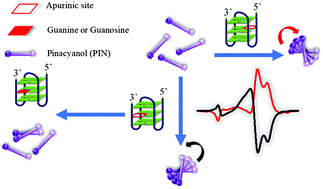G-quadruplex apurinic site-programmed chiral cyanine assemblies for specifically recognizing guanosine and guanine†
Abstract
DNA-tuned dye assemblies have received considerable attention toward developing various devices. Owing to easy conformation implementation, G-quadruplexes (G4s) have been extensively used as initiators to grow dye assemblies with controllable chiralities. However, programmed chirality regulation of dye assemblies for a given G4 sequence has not been realized in a straightforward manner. In this work, we replaced a middle guanine in the G-tracts of a human telomeric G4 with an apurinic site (AP site) to meet the programmed dye assemblies. Although all of the AP site replacements altered the G4 conformation from the hybrid to the antiparallel folding, the handedness of pinacyanol (PIN) assemblies grown on the AP site-containing G4 was programmably regulated. The G4 with the AP site at the 5′-most G-tract grew right-handed assemblies, while that with the AP site at the 3′-most G-tract grew left-handed assemblies. The handedness of assemblies almost totally mirrored each other within 450–700 nm. Interestingly, we found that the AP site provided a specific binding site for guanosine and guanine, and this binding event sensitively broke the chiral assemblies. Thus, dye assembly-based sensors can be easily established based on the chiral responses with a high selectivity and sensitivity. Our work first demonstrates the AP site programmed chirality regulation of G4-grown dye assemblies and will find wide application in chiral devices.



 Please wait while we load your content...
Please wait while we load your content...